Enduring Questions: Los Caprichos, authenticity, and reproduction
by Ivy Vance
In conjunction with Karen Koehler’s Art Questions class funded by the National Endowment for the Humanities, several groups of students worked closely with Hampshire’s permanent collection to create a curatorial project for the projection gallery in the College’s library. I worked with a group that used Francesco de Goya’s Los Caprichos, a series of 80 prints originally etched and printed between 1797 and 1799. By some twist of fate, a set of 1937 restrikes were given to the college in 1971 by Archibald MacLeish. It is one of many sets of works on paper that make up Hampshire’s Special Collections.
The Caprichos prints depict Goya’s distaste with contemporary Spanish society. Through satire and political commentary, he illustrates the hypocrisies of the of the Catholic church, the aristocracy, and popular superstitions. As a one-time court painter to 18th century Spanish royalty, Goya had more than enough material to draw upon when creating these scathing images. The most well known print from this series, The Sleep of Reason Produces Monsters, depicts the artist lost in a dream with beasts of all kinds emerging behind him. This blatant criticism of the Enlightenment era makes it clear that nothing, not even reason, was safe from Goya’s copper plate.

Although the critiques might appear dated, working with this set of restrikes raised questions about authenticity and reproduction. To begin with, the prints are not considered as valuable as their counterparts because they were not printed in the original striking. However, they still employ the use of the plates that Goya etched. Therefore, the question of what is authentic immediately becomes unsure. Furthermore, the project itself consisted of using digitized reproductions of the restrikes in order to display them on Hampshire’s projection gallery, the Magic Board. This is one of the only ways that a large number of the prints could be exhibited publicly to the student body. The notion of the authenticity of the reproduction is called into question in several ways just by displaying these prints. However, does this take away any of their original potency as art objects? Now more than ever, artists and curators are utilizing digital media to display their work. The way we display and interact with artworks is rapidly changing, and therefore definitions of what constitutes an authentic experience are as well. It is important that as we proceed we do not limit our definitions of authenticity in order to fully realize the potential of alternative modes of display.
Ivy Vance 13F is a Research Assistant at the Institute for Curatorial Practice.
Art Questions is a part of the “Enduring Questions” classes funded by the National Endowment for the Humanities.
This post is part of a series of essays, opinions, and reviews written by students, faculty, and staff of the Institute for Curatorial Practice.
